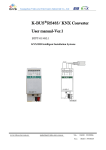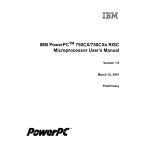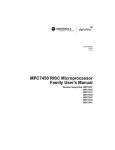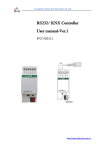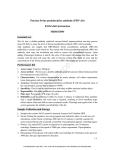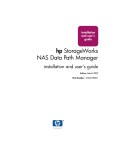Download IP/ KNX Convertor User manual-Ver.1
Transcript
Guangzhou Video-Star Electronics Co., Ltd
IP/ KNX Convertor
User manual-Ver.1
BTIC-01/00.1
http://www.video-star.com.cn
GVS
K-BUS
KNX/EIB
IP/KNX Convertor
Contents
1.
Summary --------------------------------------------------------------------------------------------------------- 3
2.
Technical Properties & Dimension and Circuit Diagram ---------------------------------------------- 4
3.
4.
2.1
Technical data------------------------------------------------------------------------------------------------- 4
2.2
Dimension diagram ------------------------------------------------------------------------------------------ 5
2.3
Circuit diagram ----------------------------------------------------------------------------------------------- 5
Project design and programming ---------------------------------------------------------------------------- 6
3.1
Overview of the functions ---------------------------------------------------------------------------------- 6
3.2
Parameter setting description in the ETS ----------------------------------------------------------------- 7
3.2.1.
Parameter window “IP settings” -------------------------------------------------------------------- 7
3.2.2.
Parameter window “IP address” -------------------------------------------------------------------- 8
Communication Protocol ------------------------------------------------------------------------------------ 10
4.1
Default Communication Protocol------------------------------------------------------------------------- 10
4.2
Command ID ------------------------------------------------------------------------------------------------- 11
4.3
READ GROUP ADDRESS ------------------------------------------------------------------------------- 12
4.4
WRITE GROUP ADDRESS ------------------------------------------------------------------------------ 14
4.5
CHANGE THE MONITOR MODE --------------------------------------------------------------------- 16
2
GVS
K-BUS
KNX/EIB
IP/KNX Convertor
1. Summary
The IP/ KNX convertor is designed for an intelligent building control system, which is used to
connect the KNX bus and the LAN. It serves as an interface between KNX installations and IP
networks. TCP telegrams from the client devices on the LAN can be converted to KNX telegrams
via the convertor, and be sent to the KNX bus to control KNX devices.
For convenient to control the KNX/EIB devices by a LAN devices, we define a communication
protocol which is transmitted on the data field of the IP packet transferred by the IP/ KNX
convertor in the chapter 4 of this manual.
The users can configure or program the IP network
devices according to the protocol to achieve the control for KNX devices.
The IP/ KNX convertor has two working modes: the monitor mode and the filter mode. In the
monitor mode, all active telegrams can be forwarded. In the filter mode, only the telegrams those
with a group address in the filter table in the IP/KNX convertor will be forwarded to the other side.
The filter table can be set via the Filter Table Setting Command from the IP network.
The IP address of the IP/KNX convertor is fixed and can be configured before running. The
power supply is not only from the KNX bus, but also need an additional 30V DC supply.
The functions of the IP/ KNX convertor are summarized as follows:
Support TCP/IP protocol, always works in TCP server mode
Transfer the communication control telegrams transparently
Support up to10 TCP connections at the same time
Transfer the TCP telegram to the KNX/EIB system to control the KNX device
Monitor the telegrams on KNX bus and transfer them to all the clients connected
Read respond telegram will only be sent to the initiator
To read and write any data type which the max length is 14 bytes defined in the KNX standard
This manual provides the technical information about the IP/KNX Convertor as well as
assembly and programming in detail for users, and explains how to use the convertor by the
application examples.
The IP/ KNX convertor is a modular installation device. It can be installed in the distribution
board on 35mm mounting rails according to EN 60 715. The device adopts an RJ45 interface to
connect with LAN. The network interface can be operated with a transmission speed of
10/100Mbit/s adaptively. The bus connection and auxiliary power supply connection are carried out
via EIB bus connection terminals.
3
GVS
K-BUS
KNX/EIB
IP/KNX Convertor
The IP/KNX convertor is able to use the Engineering Tool Software ETS (ETS3 or later) which
can import a VD4 files to allocate the physical address and set the parameters.
2. Technical Properties, Dimension and Circuit Diagram
2.1 Technical data
Power supply
Connections
Operation voltage
21-30V DC, via the EIB bus
Current consumption, KNX
<12mA
Power consumption, KNX
<360mW
Auxiliary power supply
20-30V DC
Auxiliary power consumption
<2.5W
EIB / KNX Interface
Via bus connection terminals (black/red)
Auxiliary power supply
Via bus connection terminals(grey/yellow)
RJ45 socket for10/100Base-T, IEEE 802.3
LAN
network, Adaptively
Operating and
Programming LED and button
For assignment of the physical address
display
LED Green flashing
The device running indicator
LED ON
Network connection indicator
LAN/LINK LED flashing
Telegram traffic indicator
Operation
–5 °C ... + 45 °C
Storage
–25 °C ... + 55 °C
Transport
– 25 °C ... + 70 °C
Ambient
Humidity
<93%, except condensation
Design
Modular installation device, on 35mm mounting rail
Dimensions
90×36×64mm(H×W×D)
Weight
0.1kg
Housing, colour
Plastic housing, grey
Temperature
Application program
IP/KNX convertor
Max. number of
Max. number of
Max. number of
communication objects
group address
associations
0
0
0
4
GVS
K-BUS
KNX/EIB
IP/KNX Convertor
2.2 Dimension diagram
2.3 Circuit diagram
① LED ON,indicate that the network connect status.
② LAN/LINK LED flashing, indicate that telegram traffic is ongoing.
③ Auxiliary power supply connection
④ LAN connection RJ45
⑤ Programming LED, red for assignment of physical address, green flashes for the device running well.
⑥ Programming button
⑦ EIB /KNX bus connection
5
GVS
K-BUS
KNX/EIB
IP/KNX Convertor
3. Project design and application
3.1 Overview of the functions
Open communication protocols
The communication protocols for IP Interface is open, anyone can follow the text of the
protocols to achieve communication between the IP network devices and KNX devices via IP/KNX
Converter. So you can easy to connect the KNX/EIB bus system with the IP network into a whole,
and ensure the reliability, commonality and scalability of the system internal real-time
communication, and really realize the openness of the system.
The IP/KNX convertor always works as a TCP server, support up to 10 TCP connections at the
same time.
For receiving and sending communication control telegram
The communication control telegrams are received and sent in accordance to the format which
described in the chapter 4, “communication protocol”, i.e. command format. Each data in these
command present different meaning. The detail could be seen from the table in the chapter 4.
For converting the telegram
The telegram received from the IP client by the IP/KNX convertor should be generated in strict
accordance with the communication protocol format. While receives the telegram from the IP client,
the IP/KNX convertor extract the EIB information from the telegram, such as the group address,
length, data type and value, etc, and then converted them into the KNX/EIB telegram, and sent to the
KNX/EIB system to control the KNX devices.
ACK report and executed result report
When receives a telegram from the IP client, the IP/KNX convertor will check the CRC in the
telegram first. If the telegram is correct, the IP/KNX convertor will respond to the IP client via
sending an ACK report. If the telegram is not correct, it will not respond. When the telegram is
successfully transmitted to the EIB bus, the IP/KNX convertor will send a successful telegram to the
IP client. If failure transmitted, it will send a fail telegram to the IP client (see “RESULTPKT”
telegram).
Bus monitor and filter functions
The IP client can monitor the data on the EIB bus via the IP/KNX convertor. The IP/KNX
convertor also provides filter function to group address. When the filter function is set, the IP/KNX
convertor only forwards the telegram which group address is in the filter table to the EIB bus, and
reverse. The filter table can be modified or set by the IP client device. The Maximum number of
6
GVS
K-BUS
KNX/EIB
IP/KNX Convertor
group address in the filter table is 254. General, the bus monitor mode is suitable for most of the
users.
Reading and writing data type
The data telegram that the length is less than or equal to14bytes can be sent to or read from the
EIB bus via the IP/KNX convertor.
The data which is read from the EIB bus is only forwarded to the client of the read request
initiated.
3.2 Parameters setting description for the ETS
3.2.1.
Parameter window “IP settings”
Parameter window “IP setting” is shown in fig. 3.2. Here can set the name and port number of
the IP/KNX Convertor.
Because IP convertor and RS485 convertor use the same product database, so before setting IP
convertor parameters, you must select devices first, as follow (fig.3.1):
Fig 3.1 Choose device
7
GVS
K-BUS
KNX/EIB
IP/KNX Convertor
Fig.3.2 parameter window “IP settings”
Parameter “Device name (Max. 30 Char.)”
This parameter defines the name of the IP convertor to identify the device on the LAN. Here
can entry a maximum of 30 characters in length. It is a spare parameter in current version.
Parameter “IP address assignment”
This parameter indicates that the IP address assignment of the convertor is fixed. The IP address
can be assigned in the follow parameter window “IP address”.
Parameter “Port Number of the IP Convertor”
This parameter defines the port number of the convertor, the port number of client devices must
be the same with the convertor, or their communications will fail.
3.2.2.
Parameter window “IP address”
Parameter window “IP address” is shown in fig. 3.3. Here set the network connection
information, such as IP address, Subnet mask and Default gateway.
8
GVS
K-BUS
KNX/EIB
IP/KNX Convertor
Fig 3.3 parameter window “IP address”
Parameter “IP address”
This parameter defines the IP address of the IP convertor, the IP address is unique on the LAN,
to avoid collide. Option:
Byte x: 0…255
The IP address should be entered in a byte-by-byte manner, e.g. as follows for address
192.168.1.10:
Byte1: 192
Byte2: 168
Byte3: 1
Byte4: 10
Parameter “Subnet mask”
This parameter defines the subnet mask of the IP convertor. The subnet mask must be set to
reflect the number and structure of the subnet. Option:
Byte x: 0…255
In a small network the subnet mask 255.255.255.0 should be set as follows:
Byte1: 255
Byte2: 255
Byte3: 255
Byte4: 0
9
GVS
K-BUS
KNX/EIB
IP/KNX Convertor
Parameter “default gateway”
This parameter defines the default gateway. The default gateway must be the same network
segment with the IP address. Option:
Byte x: 0…255
The default gateway 192.168.1.1 should be set as follows:
Byte1: 192
Byte2: 168
Byte3: 1
Byte4: 1
4. Communication Protocol
4.1 Default Parameters
IP address: 192.168.1.10, port number: 1000, TCP Server mode, these mean that the device
does not need to configure via ETS and can be used directly after leave factory if the client
information match with it.
Command packet
typedef struct {
BYTE
Head1;
// Always is 0x55=STX1.
BYTE
Head2;
// Always is 0xAA=STX2.
WORD
MachineID;
// Not use, default to 0.
WORD
Reserved; // Reserved
WORD
Command; // Command ID
DWORD Length;
// Input Parameter 1
WORD
InParam;
// Input Parameter 2
WORD
ChkSum; // Checksum
} CMDPKT;
// Size of command packet is 16 Bytes.
Command acknowledge packet
typedef struct {
BYTE
Head1;
// Always is 0x5A=STX1.
BYTE
Head2;
// Always is 0xA5=STX2.
WORD
MachineID;
// Not use, default to 0.
WORD
Response; // 0x00-NAK, 0x01-ACK.
WORD
ChkSum; // Checksum
} ACKPKT;
// Size of command acknowledge packet is 8 Bytes.
10
GVS
K-BUS
KNX/EIB
IP/KNX Convertor
Command execution result packet
typedef struct {
BYTE
Head1;
// Always is 0xAA=STX1.
BYTE
Head2;
// Always is 0x55=STX2.
WORD
MachineID;
// Not use, default to 0.
WORD
Reserved; // Reserved
WORD
Ret;
// 1: OK 0: Error
DWORD OutParam; // Output Parameter
WORD
ChkSum; // Checksum
} RESULTPKT;
// Size of command execution result packet is 14 Bytes.
Instruction:
A. The IP client send command using format of CMDPKT to the convertor. When the command is
arrived, the IP/KNX convertor will reply an ACK using the format of ACKPKT to the IP client,
if the IP client does not receive the ACK after a time, it will be considered that the transmission
is failure and decide whether to re-send.
B. After the command was executed, the convertor will report the execute result using the
format of structure RESULTPKT.
C. When write a Group Address Value which has more than 2 bytes Object Value, the Object
Value should be sent in another data packets, the Setting Data Command, to the Convertor.
D. When read a Group Address, need to ensure that the Communication Object has the
read/write/transmit enable. All the responds will be sent to the client in data packets.
E.The protocol for monitor mode and filtering mode is not suitable for all users now. We will
provide them in another document when need.
F. You should know the IP address and the port number of the IP Converter and have to link to
it with TCP protocol before using it. The IP Converter could be configured by ETS Tools!
G. The IP/KNX convertor always works as TCP server. In the monitor mode, the telegrams
received from the KNX bus will be sent to all the clients that have connected to IP/KNX
convertor. But the read respond telegram will only be sent to the initialize.
H. Only 10 TCP connections allowed at a time. Do not support UDP mode temporary.
4.2 Command ID
enum // The command ID for the connection.
{
CMD_SET_MONITOR_MODE = 0x101,
CMD_SET_FILTER_MODE,
CMD_SET_RANDOM_MODE,
//This command is not available now
CMD_GROUP_ADDR_READ,
CMD_GROUP_ADDR_WRITE
};
11
GVS
K-BUS
KNX/EIB
IP/KNX Convertor
4.3 BOOL ReadGroupAddr(CMDPKT* pCMD)
Function: Read the Group Address
Parameters:
Return: 1—OK;
0—Error;
PROTOCOL:
Byte
1
2
3
4
5
6
7
8
9
10
11
12
13
14
15
16
0x55
0xAA
COMMAND(Client----IP/KNX Convertor)
Value
Meaning
Always is 0x55
Always is 0xAA
1--255, 0 = default
Not use, default to 0.
0
Reserved
CMD_GROUP_ADDR_READ
Command ID
nConfig(NOTE 1)(We used the lowest 2
bits as the priority, usually it equals
0x03)
nLength(NOTE 2)
Input Parameter 1
DEST ADDR(NOTE 3)
0
Input Parameter 2
ChkSum
Checksum(NOTE 4)
12
GVS
K-BUS
Byte
1
2
3
4
5
6
7
8
Byte
1
2
3
4
5
6
7
8
9
10
11
12
13
14
Byte
1
2
3
4
5
6
7
8
9
10
11
KNX/EIB
IP/KNX Convertor
ACK(IP/KNX Convertor ---- Client)
Value
Meaning
Always is 0x5A
Always is 0xA5
0x5A
0xA5
1--255, 0 = default
Not use, default to 0.
0x00-NAK
0x01-ACK.
Response
ChkSum
Checksum(NOTE 4)
0xAA
0x55
EXERESULT (IP/KNX Convertor ---- Client)
Value
Meaning
Always is 0xAA
Always is 0x55
1--255, 0 = default
Not use, default to 0.
0
Reserved
1: OK 0: Error
Result
0
Output Parameter
ChkSum
Checksum(NOTE 4)
0xA5
0x5A
Data respond(IP/KNX Convertor ---- Client)
Value
Meaning
Always is 0xA5
Always is 0x5A
1--255, 0 = default
Not use, default to 0.
SRC ADDR(NOTE 5)
The Physical Address of the source
DEST ADDR(NOTE 3)
Destination Group Address
nLength
// Group communication Multicast
APCI_VALUE_READ
0x0000
APCI_VALUE_RESP
0x0040
APCI_VALUE_WRITE
0x0080
The Length of the Value
APCI of EIB telegram
1~14 Bytes of Value
13
GVS
K-BUS
19
20
KNX/EIB
IP/KNX Convertor
Checksum(NOTE 4)
ChkSum
4.4 BOOL WriteGroupAddr(CMDPKT* pCMD)
Function: Write the Group Address
Parameters:
Return: 1—OK;
0—Error;
PROTOCOL:
Byte
1
2
3
4
5
6
7
8
9
10
11
12
13
14
15
0x55
0xAA
COMMAND(Client----IP/KNX Convertor)
Value
Meaning
Always is 0x55
Always is 0xAA
1--255, 0 = default
Not use, default to 0.
0
Reserved
CMD_GROUP_ADDR_WRITE
Command ID
nConfig(NOTE 1) (We used the lowest
2 bits as the priority, usually it
equals 0x03)
nLength(NOTE 2)
Input Parameter 1
DEST ADDR(NOTE 3)
(nLength <= 2) : Group Value
Else : 0
ChkSum
Input Parameter 2
Checksum(NOTE 4)
14
GVS
K-BUS
KNX/EIB
IP/KNX Convertor
16
Byte
1
2
3
4
5
6
7
8
Byte
1
2
3
4
5
6
7
8
9
10
11
12
13
14
Byte
1
2
3
4
5
6~
17
ACK(IP/KNX Convertor ---- Client)
Value
Meaning
Always is 0x5A
Always is 0xA5
0x5A
0xA5
1--255, 0 = default
Not use, default to 0.
0x00-NAK
0x01-ACK.
Response
ChkSum
Checksum(NOTE 4)
0xAA
0x55
EXERESULT (IP/KNX Convertor ---- Client)
Value
Meaning
Always is 0xAA
Always is 0x55
1--255, 0 = default
Not use, default to 0.
0
Reserved
1: OK 0: Error
Result
0
Output Parameter
ChkSum
Checksum(NOTE 4)
0x5A
0xA5
Setting Data(Client----IP/KNX Convertor)
Value
Meaning
Always is 0x5A
Always is 0xA5
1--255, 0 = default
Not use, default to 0.
3~14 Bytes of Value(nLength >= 3) : Group
Value
18
19
20
ChkSum
Checksum(NOTE 4)
15
GVS
K-BUS
KNX/EIB
IP/KNX Convertor
4.5 BOOL ComMonitorModeChange(CMDPKT* pCMD)
Function: Change the monitor mode;
Parameter:
Return: 1 — OK;
0 –- Error;
PROTOCOL:
Byte
1
2
3
4
5
6
7
8
9
10
11
12
13
14
15
16
Byte
1
0x55
0xAA
COMMAND(Client----IP/KNX Convertor)
Value
Meaning
Always is 0x55
Always is 0xAA
1--255, 0 = default
MachineID
0
Reserved
CMD_SET_MONITOR_MODE ||
CMD_SET_FILTER_MODE
Command ID
CMD_SET_MONITOR_MODE:0
CMD_SET_FILTER_MODE:(1~
Input Parameter 1
254),the length of filter table.
0
Input Parameter 2
ChkSum
Checksum(NOTE 4)
0x5A
ACK(IP/KNX Convertor ---- Client)
Value
Meaning
Always is 0x5A
16
GVS
K-BUS
2
3
4
5
6
7
8
Byte
1
2
3
4
5
6
7
8
9
10
11
12
13
14
Byte
1
2
3
4
19
20
KNX/EIB
IP/KNX Convertor
0xA5
Always is 0xA5
1--255, 0 = default
MachineID
0x00-NAK
0x01-ACK.
Response
ChkSum
Checksum(NOTE 4)
EXERESULT(IP/KNX Convertor ---- Client)
Value
Meaning
Always is 0xAA
Always is 0x55
0xAA
0x55
1--255, 0 = default
MachineID
0
Reserved
1: OK 0: Error
Result
0
Output Parameter
ChkSum
Checksum(NOTE 4)
0x5A
0xA5
Setting Filter Table(Client----IP/KNX Convertor)
Value
Meaning
Always is 0x5A
Always is 0xA5
1--255, 0 = default
MachineID
High Byte of the Group Address
Low Byte of the Group Address
High Byte of the Group Address
Low Byte of the Group Address
…High Byte
…Low Byte
…High Byte
…Low Byte
Max Data:254*2 Bytes(The Lower Byte of
the Group Address follows the higher Byte,
and they should be marked in ascending
order, for example, Group Address 00-05
should be placed before 00-06, also 00-05
should be placed before 01-05).
ChkSum
Checksum(NOTE 4)
NOTE 1: According to KNX Standard, it has 4 types, corresponding to 4 Transmission Priority:
11 = low operational priority
17
GVS
K-BUS
KNX/EIB
IP/KNX Convertor
10 = high operational priority
01 = alarm priority
00 = system priority
Usually we use LOW priority, so the nConfig will be 0x03, others are not recommended.
NOTE 2: The length of the Communication Object which was linked to the DEST ADDR according
to the KNX standard, e.g. when the Communication Object less than 1 byte it equals to1,
otherwise it equals to length + 1.That is say, when we have a 1 bit CO, then the nLength
should equals to 0x01, while a 1 byte CO will have the nLength equals to 0x02.
NOTE 3: Destination Group Address which you want to read or write.
NOTE 4: The sum of all the data bytes before.
NOTE 5: The Physical Address of the device from whom sends out the telegram.
18


















